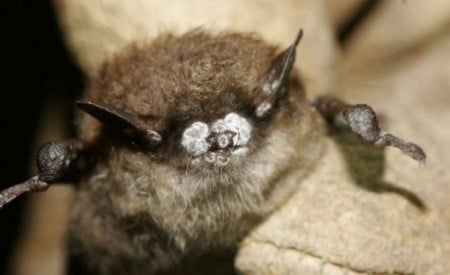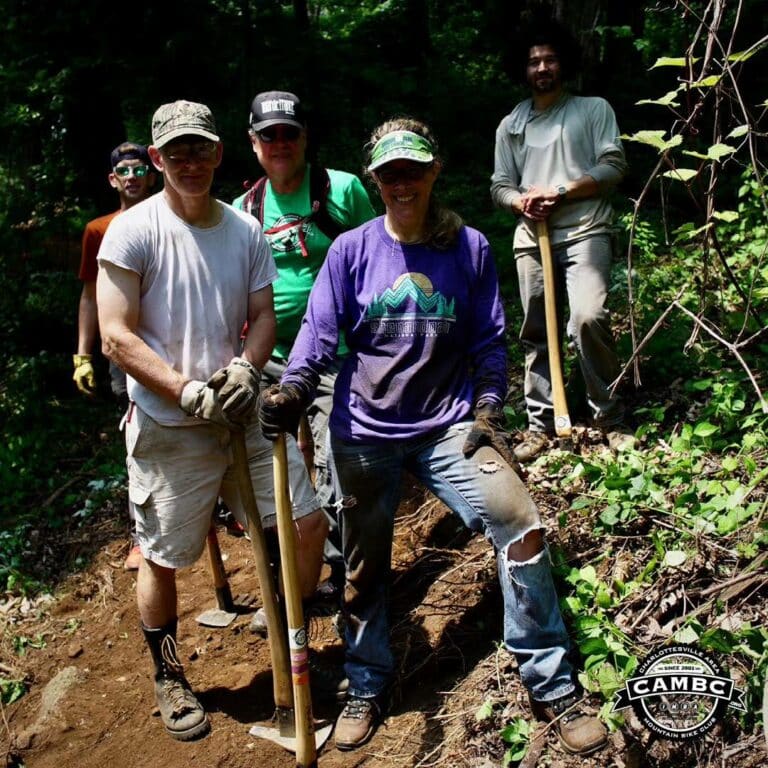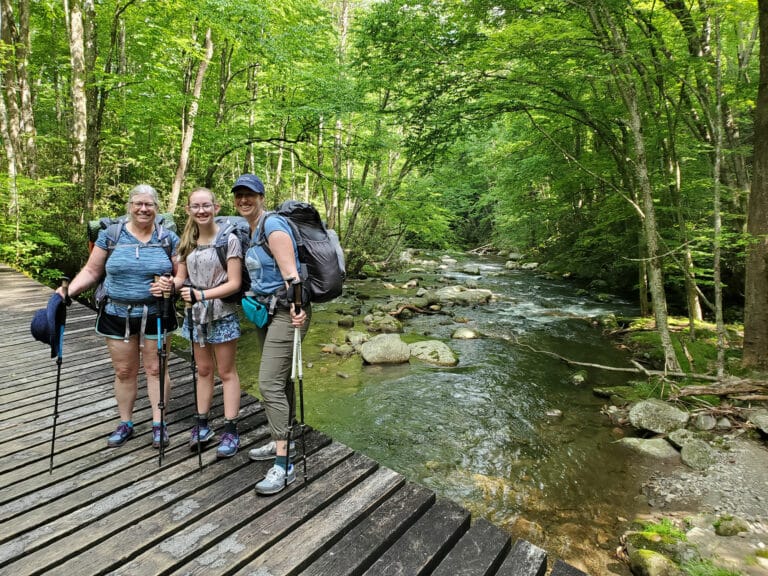Driving along the Blue Ridge Parkway on an overcast New Year’s Day, Luke Appling, a park ranger at Grandfather Mountain State Park, saw a very strange sight: a bat flying in the middle of the day. The bat’s flight was clumsy and uncoordinated, as it flew into nearby branches. Appling knew something was wrong with this bat.
Bats flying during the daytime are becoming a common and widespread phenomenon in western North Carolina. Sightings have been called in from rangers at Grandfather Mountain, hikers in Mills River, and staff at the Waynesville Water Treatment Plant. This odd behavior is a side-effect of a disease called White-nose Syndrome (WNS). WNS is caused by a newly discovered fungus called Geomyces destructans, which thrives in the cold, damp climates of caves and mines. As bats hibernate, their immune systems are suppressed and their body temperature falls within a degree of the surrounding temperature of the cave. This makes the bats a perfect host for G. destructans to grow on. The fungus actively invades exposed living skin tissue on areas such as the wings, muzzle, ears, and feet of the bats. The bats awake more frequently from hibernation to groom off the fungus, using up precious fat reserves that should last the entire winter. As a result, bats may wake up and fly outside in search of food and water. But when bats exit their hibernacula in the middle of winter, they find freezing temperatures and very few insects to eat.
WNS is a particularly devastating disease due to its rapid spread, lack of discrimination between different bat species, and catastrophically high mortality rates. WNS was discovered in Howe’s Cave in New York State in the winter of 2006 and has since spread to 16 states in the eastern U.S. and 4 Canadian Provinces, currently reaching its most southern extent in North Carolina. Mortality from WNS was recently estimated to be over 5.5 million bats since 2006, with regional population declines estimated at 73-88%. Six species of bats are confirmed to be affected by the disease, including the federally endangered Indiana bat (Myotis sodalis). The northern long-eared bat (Myotis septentrionalis), the eastern small-footed bat (Myotis leibii), and the little brown bat (Myotis lucifugus) are currently being considered for listing under the Endangered Species Act due to declines as a result of WNS. The little brown bat was once considered the most common bat species in the Northeast, but this species’ population has declined so drastically from WNS that biologists believe that little brown bats could be regionally extinct from the Northeast in less than 16 years.
In 2009, the U.S. Fish and Wildlife Service issued a voluntary moratorium on caving in WNS positive states and adjacent states to prevent human transportation of G. destructans spores. “We are asking people not to enter caves and mines while researchers work to learn more about White-nose Syndrome,” says Sue Cameron, an Endangered Species Biologist for the U.S. Fish and Wildlife Service (USFWS). “While the primary mode of transmission of the disease appears to be from bat-to-bat, there is concern that people can inadvertently carry and spread fungal spores to new sites. We want to do whatever we can to slow the spread of the disease and prevent large jumps to uninfected states or areas of the country. If people do choose to enter caves and mines, we ask that they follow the USFWS decontamination protocols (http://www.fws.gov/whitenosesyndrome/pdf/WNSDecon_Cavers_v012511.pdf) to reduce the chance of spreading the spores.” Many caves and mines on federal and state lands have been closed to the public, although some privately-owned caves are still open. Local caving groups, such as the Flittermouse Grotto, follow USFWS decontamination protocol to prevent spreading spores between caving sites. Linville Caverns, a site that was confirmed as WNS positive in 2011, requires visitors to decontaminate their shoes after they leave the cave.
WNS was first discovered in North Carolina last winter in February 2011 and it has now been documented in 4 counties, with 2 additional counties considered suspect for the disease. Winter bat hibernation surveys for the 2012 season have not yet been completed, but the NCWRC biologists are already seeing indications of declines in the number of bats hibernating in some of the state’s caves and mines. “Folks were holding on to a little bit of hope that White-nose Syndrome would behave differently in the south,” says Cameron. “We are hoping that something about our climate or our bats would curtail the high mortality rates seen in the Northeast. But unfortunately, reports from biologists in Virginia and our recent winter surveys in North Carolina suggest that our bats may be just as unlucky as their cousins up north.”
“White-nose Syndrome is the most devastating wildlife disease of our time,” states Gabrielle Graeter, a Wildlife Biologist with the NCWRC’s Wildlife Diversity Program. “We are still hopeful that we won’t see the declines in our bat populations that biologists up North have seen. Unfortunately, there isn’t much we can do to help the bats right now other than monitor the spread of the disease and hope for the best.”
Corinne Diggins is a NCWRC Wildlife Diversity Technician and head of the North Carolina Bat Acoustic Monitoring Program. She has been monitoring North Carolina’s bat populations since 2010.
Help the NCWRC Monitor Bat Populations
If you see bats flying during the day or roosting in areas exposed to the elements during the winter, please write down the date, time, location, # of bats and their behavior, and the weather conditions and email them to Gabrielle Graeter at [email protected]
Help monitor bats this summer with the North Carolina Bat Acoustic Monitoring Program! As a volunteer, you’ll place a microphone for an ultrasonic bat detector on the roof of your car and drive along a predetermined route, recording bat calls. Contact Corinne Diggins for more information at 828-273-3991 or [email protected].
Donate to the NCWRC’s Nongame and Endangered Wildlife Fund: The Nongame and Endangered Wildlife Fund helps fund the conservation of bats and monitoring of White-nose Syndrome in the state of North Carolina. Donations can be made through: 1) donating through the Tax Check-off for Nongame and Endangered Wildlife on your N.C. State Income tax form, 2) registering a vehicle or trailer with a N.C. Wildlife Conservation license plate, or 3) mailing in a contribution form, which can be downloaded at ncwildlife.org/give.








